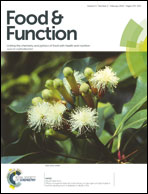Effects of heme iron enriched peptide on iron deficiency anemia in rats
Abstract
The present study aims to investigate whether a daily intake of heme iron enriched peptide obtained from bovine hemoglobin is effective in alleviating iron deficiency anemia (IDA). Wistar rats were randomly divided into six groups: a control group, an anemic group not treated, and anemic groups treated with FeSO4 or with the heme iron enriched peptide at low, moderate or high doses. The rats in the anemic groups were fed on a low-iron diet to establish the iron deficiency anemia model. After the model had been established, different doses of heme iron enriched peptide were given to the rats once a day via intragastric administration. After the iron supplement administration, it was observed that heme iron enriched peptide had effective restorative action returning the hemoglobin, red blood cells, hematocrit, mean corpuscular volume, mean corpuscular hemoglobin concentration and serum iron in IDA animals to normal values or better. In addition, compared with FeSO4, higher Fe bioavailability and fewer side effects were observed. The rats in the moderate dose group had the highest apparent Fe absorption. Moreover, in vivo antioxidant activity was also observed, enhancing the activities of antioxidant enzymes and reduced malondialdehyde levels in IDA rats. Furthermore, the heme iron enriched peptide also exhibited strong in vitro antioxidant activities. In conclusion, heme iron enriched peptide significantly alleviated iron deficiency anemia, and exhibited strong in vitro and in vivo antioxidant activities. This suggests that heme iron enriched peptide might be exploited as a safe, efficient new iron supplement.


 Please wait while we load your content...
Please wait while we load your content...